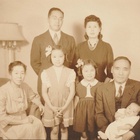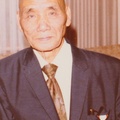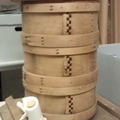How Jichan Became an Araki
Although Jichan was born Nisaku Kaneda, the second of four sons in the Kaneda family of Fukui-ken, when he married, he took the family name of his wife, Masa Araki, acting as a yoshi, so that the Araki family name could be continued. Jichan, around twenty-seven years old, and Bachan, about twenty, were married in Tacoma, WA in December of 1913.
Bachan was an only child, and as a female, she could not carry on the Araki name for the Tokyo branch of the Araki family that was established by her father, Kyuzo Araki. Bachan grew up in Tokyo. Family members have told me that she went to school in a jinrikisha, so she had a privileged upbringing. Bachan was well-educated, as was Jichan, who, before he came to America at around age 20, was a middle school teacher specializing in agriculture in Tsuruga City, Fukui-ken. However, the family myth that Jichan met Bachan at a university is unlikely to be true because Bachan was born on April 6,1893 while Jichan was born on October 25, 1886, so there was more than a seven-year age difference between them.
My father, Toru Araki, was born in America in December 1914. Around 1916, when he was only two years old, he was sent to Iwate-ken, Japan and raised by Kyuzo Araki—Bachan's father. In 1922, when he was about eight, Dad was returned to his parents in the U.S., accompanied by his maternal grandfather, Kyuzo Araki. Since Father was born in the United States to citizens of Japan, he held Japanese citizenship according to Japanese law and American citizenship according to American law. Dad was always meant to run the family greenhouse business in America because, as a U.S. citizen, he could own land.
Dad’s younger brother, Shigeru, was born in Japan. Bachan had traveled all the way to Tokyo so that Shigeru could be born in Japan in March 1916. It’s only a theory, but I believe Shigeru was meant to be the Araki who carried on the Araki family name in Tokyo. Tragically, Shigeru died in July 1917. My Great Grandfather Kyuzo Araki, Bachan’s father, was the second son in his family, so he started a new branch of the Araki family in Tokyo in 1920, shortly after the birth of my father’s younger brother, Minoru, in America. The original branch of the Araki family, headed by Kyuzo Araki’s elder brother, Genemon Araki, remained in Rikuzentakata in Iwate-ken.
After Shigeru’s death, perhaps Kyuzo Araki hoped that my father would return to Japan and carry on the Araki family name in Tokyo. It is certain that a few months after my Great Grandfather Araki, Kyuzo, died in December 1933, my father gave up his Japanese citizenship. Jichan formally declared this to the Japanese Consulate in Seattle on July 23,1934. It is also very possible that Father renounced his Japanese citizenship to avoid being drafted into the Japanese Army, should Father ever return to Japan. This happened to my kibei father-in-law, “Mac” Yamamura, who was drafted into both American and Japanese armies.
How Jichan Came to America
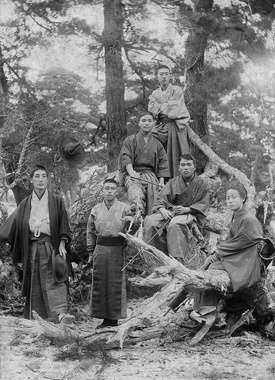
My Jichan was quiet man. I remember only a few occasions when he attempted, at length, to communicate with me. It was around the time that he was interviewed by Kazuo Ito, a historian and newspaper reporter, who was in the process of compiling his important book, Issei: A Story of Japanese Immigration in North America (the English title) or Hyakunen Sakura (the Japanese title.) I regret that my lack of facility with spoken and written Japanese hampered my ability to communicate with both Jichan and Bachan. Around the same time that Mr. Ito (who was a good friend of my father-in-law) began interviewing Jichan, Jichan shared some of his adventures in America with me. Later, I found most of these stories in Mr. Ito’s book. For example, I learned that Jichan had been lured to America by articles he saw in an Osaka newspaper around 1905 or 1906. On page 38 of Issei, Jichan explains that he had once been a 3rd, 7th and 8th grade teacher at Matsubara Elementary School in Tsuruga.
Life in America
Jichan entered the United States in Seattle, WA on February 21, 1906, disembarking from the British ship, “Athenian” (called the “Azanian” in Issei), after stopping in Vancouver, B.C. Just before disembarking, Jichan discovered that he had been robbed of all his money, including the $50 misekin, or “show money” to prove to the immigration official that he was self-sufficient, and about $20 for personal expenses. When he was asked if he had the $50 “show money,” Jichan gulped and said, “Yes!” Luckily, he was not asked to actually show the $50 and so successfully entered the U.S. Mr. Hisashi Fujii, an old classmate from Fukui Agricultural School, was on the same ship and kindly lent Jichan some money to tide him over until Jichan could find work. Jichan quickly regretted leaving a relatively genteel job as a teacher in Japan for the rough life of an immigrant laborer in America.
Within a few months, Jichan was joined by his elder brother, Shinsaku Kaneda, nicknamed “Chachan.” Jichan and Chachan worked numerous tough, manual labor jobs of the Old West, including logging in Yakima and Tacoma, WA, working in the Great Northern railroad yard in Whitefish, MT and working as a gardener in Roche Harbor on Sand Juan Island in Washington State (see “Jichan in America”, Discover Nikkei, 27 June 2017.) Jichan also tried his hand at working alone, very briefly and unsuccessfully, selling vegetables from a horse-drawn cart. Later, I believe that Jichan found that he was better at growing vegetables than peddling them. After all, Jichan had taught agriculture in Japan. He loved growing vegetables and flowers. I remember eating the delicious fruits and vegetables he grew at our home in South Park, Seattle.
In 1909, Jichan had a very good job as an “engineer” at the famed Rainier Club in Seattle. He also cultivated land and grew vegetables, which were probably sold at the famed Pike Place Public Market. Selling vegetables means that Jichan had found a way to work the land and to possibly even own property through a trustworthy white legal guardian since the Alien Land Laws prevented Jichan from owning land in his own name. By 1912, the year when the Meiji era ended in Japan, Jichan had enough money to support a wife and so a marriage was arranged between Jichan and Bachan. At first, they lived in rented Seattle apartments.
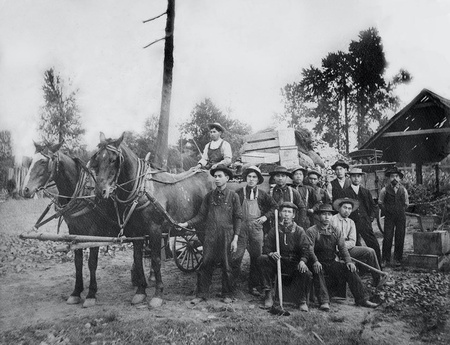
The First House at 839 South Elmgrove Street
By 1922, Jichan and Bachan were living at 839 South Elmgrove St. in Seattle in a white shingled house. Dad was born about six months after World War I began. It is likely that Jichan and Bachan survived the 1918 to 1920 Spanish “flu” pandemic in this house.
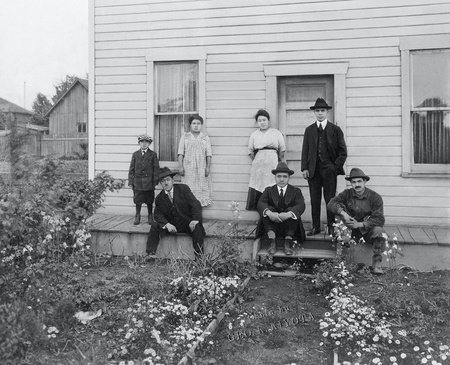
In spite of the constantly shifting Alien Land Laws prohibiting ownership of land by Asian non-citizens (who were also not allowed to become naturalized U.S. citizens) and the Great Depression (1929-1939), Jichan and Bachan worked hard and prospered. Between 1922 and 1938, Jichan built a red brick Tudor style house which still stands today at the same general location as the white shingled house. Streets have been blocked off and reconfigured in recent times so the old address no longer exists. Our old home has been incorporated into part of the offices of Solid Ground Transit. It’s likely that the first house became the “boiler house,” with a basement that held the steam boiler that heated the greenhouses on the property. In later years, we made mochi for New Year’s Day in the boiler house.
Jichan continued his day job at the Rainier Club, where he was entrusted with the keys to the meat locker and maintained the steam heating system. He and Bachan grew vegetables, managed a florists’ shop at the Pike Place Public Market and Bachan also sold vegetables at a rented stall in the “Market.” I remember Bachan selling vegetables there. Once or twice, for a few minutes, I worked at the market selling vegetables in her place, so that she could have a short break.
The Last House at 839 South Elmgrove Street in Seattle Washington
By 1938, Father had graduated from the University of Washington and his younger brother Minoru was attending the University of Washington in pre-med studies. Photos from that time show a very prosperous looking Jichan and Bachan with Uncle Minoru and Father seated beside them. Mother and Father were married in 1939 and I was their first child, born in 1940. The home that my sister Louise, my younger brothers, Steve and Larry and I all remember so fondly is this home below:
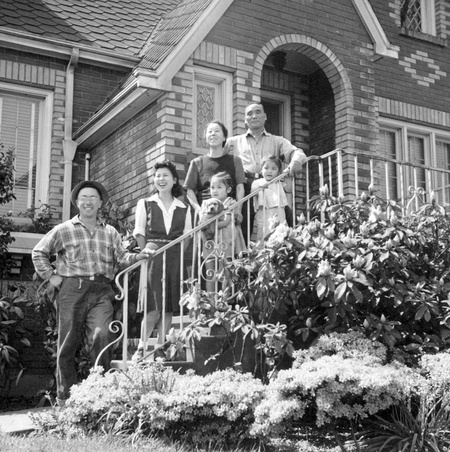
By the time I was born in May of 1940, in spite of all the odds against them, Jichan and Bachan had succeeded in America and had a beautiful brick home, greenhouses, a florist shop and vegetable stall at the Pike Place Public Market. Jichan and Bachan had achieved the American Dream.
© 2020 Susan Yamamura


